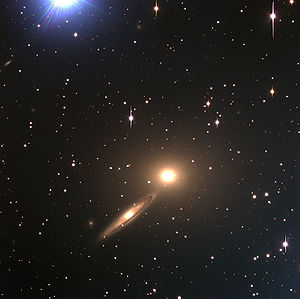NGC 5090
| Galaxy NGC 5090 |
|
|---|---|

|
|
| Galaxy pair NGC 5090 - 5091 | |
| AladinLite | |
| Constellation | centaur |
|
Position equinox : J2000.0 , epoch : J2000.0 |
|
| Right ascension | 13 h 21 m 12.8 s |
| declination | -43 ° 42 ′ 16 ″ |
| Appearance | |
| Morphological type | E2 / LINER |
| Brightness (visual) | 11.5 likes |
| Brightness (B-band) | 12.5 mag |
| Angular expansion | 2.7 ′ × 2.2 ′ |
| Position angle | 109 ° |
| Surface brightness | 13.5 mag / arcmin² |
| Physical data | |
| Affiliation |
NGC 5011 group NGC 5090 group LGG 339 |
| Redshift | 0.011411 ± 0.000070 |
| Radial velocity | 3421 ± 21 km / s |
|
Stroke distance v rad / H 0 |
(145 ± 10) · 10 6 ly (44.6 ± 3.1) Mpc |
| history | |
| discovery | John Herschel |
| Discovery date | June 3, 1834 |
| Catalog names | |
| NGC 5090 • PGC 46618 • ESO 270-G002 • MCG -07-27-54 • 2MASX J13211286-4342168 • SGC 131818-4326.6 • GC 3496 • h 3487 • AM 1318-432 • LDCE 916 NED160 | |
NGC 5090 is an elliptical galaxy with an active nucleus of the Hubble type E2 in the constellation Centaur in the southern sky . It is estimated to be 145 million light years from the Milky Way and about 125,000 light years in diameter. The galaxy forms an interacting galaxy pair with NGC 5091 . A radio jet (FRI radio galaxy) with the designation PKS 1318-43 was also identified in NGC 5090 . In the vicinity of NGC 5090 there are two more galaxies, which were named PGC 46442 ( NGC 5090A ) and PGC 46528 ( NGC 5090B ).
The object was discovered on June 3, 1834 by the British astronomer John Herschel , who observed "pretty faint, round, 30 arcseconds. The third of four "noted. The other galaxies in this group are NGC 5082 , NGC 5086, and NGC 5091 .
Web links
- GoBlack
- Capella Observatory
- ESO
- A radio and optical study , bibcode : 1986ApJ ... 308 ... 36S
- Galaxy in collision
- NGC 5090. SIMBAD , accessed May 27, 2015 .
- NGC 5090. DSO Browser, accessed May 27, 2015 .
